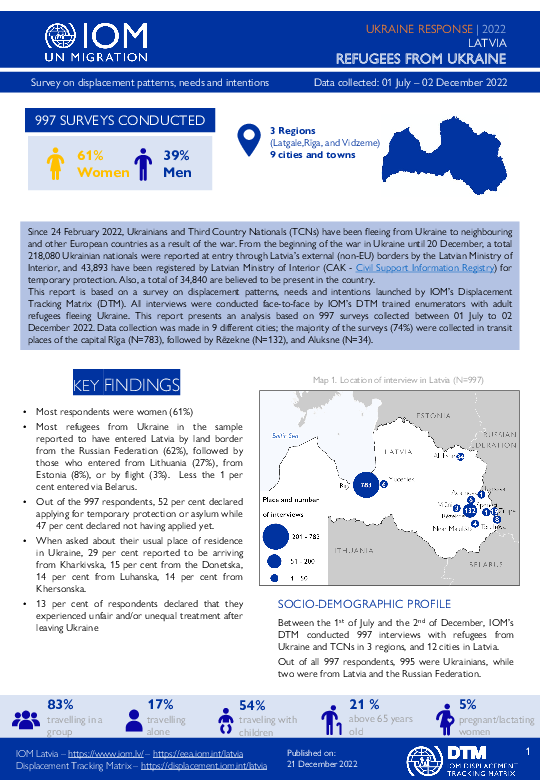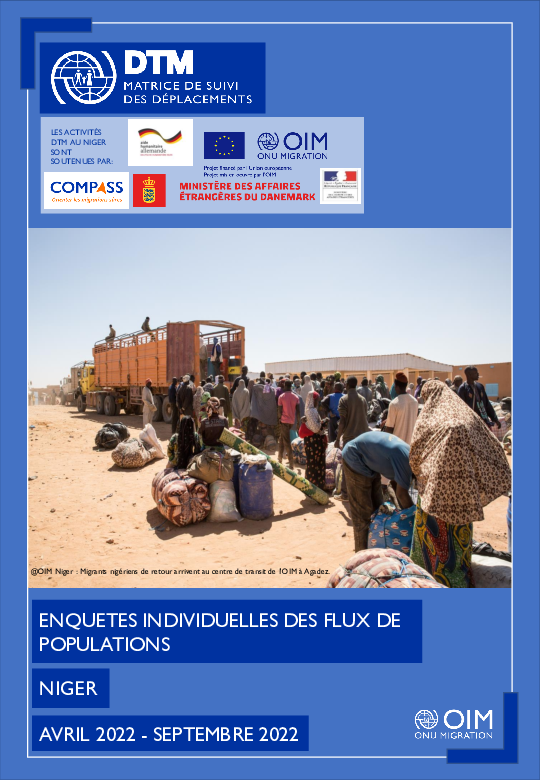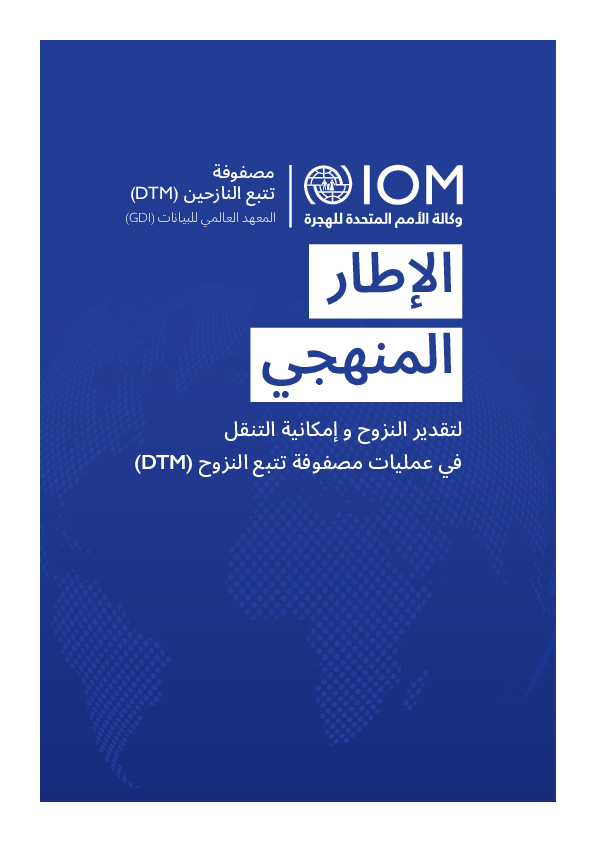-
Countries
-
Data and Analysis
-
Special Focus
-
Crisis Responses
Dec 21 2022
Print
Type
Methodological framework
Published date
Wed, 12/21/2022 - 17:11

Contact
DTM Europe, DTMMediterranean@iom.int
Language
English
Location
Latvia
Period Covered
Jul 01 2022
Dec 02 2022
Activity
- Survey
- Flow Monitoring
Since 24 February 2022, Ukrainians and Third Country Nationals (TCNs) have been fleeing from Ukraine to neighbouring and other European countries as a result of the war. From the beginning of the war in Ukraine until 20 December, a total 218,080 Ukrainian nationals were reported at entry through Latvia’s external (non-EU) borders by the Latvian Ministry of Interior, and 43,893 have been registered by Latvian Ministry of Interior (CAK - Civil Support Information Registry) for temporary protection. Also, a total of 34,840 are believed to be present in the country. This report is based on a survey on displacement patterns, needs and intentions launched by IOM’s Displacement Tracking Matrix (DTM). All interviews were conducted face-to-face by IOM’s DTM trained enumerators with adult refugees fleeing Ukraine. This report presents an analysis based on 997 surveys collected between 01 July to 02 December 2022. Data collection was made in 9 different cities; the majority of the surveys (74%) were collected in transit places of the capital Rīga (N=783), followed by Rēzekne (N=132), and Aluksne (N=34).

Contact
DTMUkraine@iom.int
Language
English
Location
Ukraine
Period Covered
Nov 28 2022
Dec 11 2022
Activity
- Mobility Tracking
- Baseline Assessment
The IDP Area Baseline assessment provides granular data on the number and geographic location of officially registered internally displaced persons (IDPs). Data collection for the Area Baseline assessment Round 18 took place between 28 November and 11 December across 22 oblasts and Kyiv city. Since last round, DTM has expanded its geographical coverage by collecting the IDP figures from local authorities in Donestka oblast. In the areas covered, the number of recorded IDPs was collected for all 109 raions and 948 hromadas (71 per cent of all hromadas in the covered oblasts). In addition, gender disaggregated figures were provided across 52 per cent of hromadas – in those areas, 61 per cent of registered IDPs were females and 39 per cent were males in assessed locations.
This report assesses registered IDP presence at the hromada and oblast-levels, while also mapping the percentage change since the previous round. It further highlights the rate of change at the macro-regional level and charts the registered IDP figures at the raion-level across the previous 10 rounds.

Contact
DTMUkraine@iom.int
Language
English
Location
Ukraine
Period Covered
Nov 28 2022
Dec 11 2022
Activity
- Baseline Assessment
Базова оцінка території ВПО надає детальні дані щодо кількості та географічного розташування офіційно зареєстрованих внутрішньо переміщених осіб (ВПО). Збір даних для 18-го туру базової оцінки території відбувався з 28 Листопада по 11 Грудня в 21 області та місті Києві. З минулого раунду МВП розширила своє географічне охоплення, зібравши дані про ВПО від місцевої влади Донецької області. У охоплених областях кількість зареєстрованих ВПО була зібрана для всіх 109 районів і 948 громад (71 відсотків від загальної кількості громад). Крім того, дані з розбивкою за статтю були надані для 52 відсотків з охоплених громад: з цих територій 61 відсотки ВПО були жіночої статі та 39 відсотків чоловічої статі.
У цьому звіті оцінюється присутність ВПО на рівні громади та області, а також відображається відсоткова зміна рівня ВПО з попереднього раунду. Крім того, у ньому висвітлюється швидкість змін на макрорегіональному рівні та представлені офіційні цифри ВПО на районному рівні за попередні 10 турів.

Contact
DTM Niger, DTMNiger@iom.int
Language
English
Location
Niger
Period Covered
Apr 01 2022
Sep 30 2022
Activity
- Survey
- Flow Monitoring Survey
- Flow Monitoring
Afin de mieux comprendre les mouvements et les tendances migratoires en Afrique de l’Ouest et du Centre, l’Organisation internationale pour les migrations (OIM), à travers la Matrice de suivi des déplacements (Displacement Tracking Matrix (DTM) en anglais), met en œuvre l’activité de Suivi des flux de populations (Flow Monitoring (FM) en anglais).
Le suivi des flux, qui est mis en œuvre en étroite collaboration avec les autorités et des partenaires nationaux et locaux, est composé de deux outils : l’enregistrement des flux (Flow Monitoring Registry (FMR) en anglais), qui recueille des données clés sur l’ampleur, la provenance, la destination et les modalités des flux de mobilité. À cela s’ajoute, les enquêtes individuelles (Flow Monitoring Survey (FMS) en anglais), conduites auprès des voyageurs afin d’obtenir des informations sur les profils, les parcours migratoires, et les intentions des migrants. Le suivi des flux de populations récolte ainsi des données sur les flux et les tendances migratoires, les profils des voyageurs, les parcours et les intentions des migrants, afin de fournir une meilleure compréhension des mobilités en Afrique de l’Ouest et du Centre.
Au Niger, la DTM recueille des données à sept points de suivi des flux (Flow Monitoring Point (FMP) en anglais), dans le but d’identifier les zones à forte mobilité transfrontalière et intra régionale, et récolter des données sur les tendances de mobilités, les profils et les parcours des voyageurs dans le pays.
Ce rapport présente les données obtenues au travers des activités FMR et FMS d'avril à septembre 2022, au niveau des sept FMP installés au Niger.
Pour plus d’information sur la méthodologie du suivi des flux, merci de consulter la dernière page de ce rapport.
La transhumance est une pratique de longue date en Mauritanie où elle a évolué au cours des dernières décennies avec la raréfaction des routes empruntées par les troupeaux notamment affectés par une raréfaction des ressources. Par conséquent, des conflits peuvent survenir entre les agriculteurs et les éleveurs transhumants. Dans le cadre du Suivi des Mouvements de Transhumance, l’OIM met en œuvre un système d’alerte qui a pour objectif de recenser les mouvements inattendus de bétail et les conflits ou catastrophes liés à l’utilisation des ressources naturelles et aux interactions entre agriculteurs et éleveurs, de comprendre les modes de résolution de conflits existants et d’informer les autorités compétentes, dans l’objectif de réduire et prévenir les tensions dans les régions d’intervention. Ce tableau de bord présente les informations fournies par le biais de 21 informateurs clés, présents dans huit régions (Assaba, Brakna, Gorgol, Guidimakha, Hodh El Chargui, Hodh El Gharbi, Tagant et Trarza) pendant le mois d’octobre 2022.
Contact
DTMUkraine@iom.int
Location
Ukraine
Activity
- Mobility Tracking
- Baseline Assessment
Period Covered
Nov 28 2022 -Dec 11 2022
A baseline assessment is a sub-component of mobility tracking. It aims to collect data on IDP, migrant or returnee population presence in a defined administrative area of the country.
This is a restricted dataset. To get access, kindly click on the 'Request Access' button.
Population Groups
IDPs
Survey Methodology
Unit of Analysis Or Observation
Admin Area 2
Type of Survey or Assessment
Key Informant
Keywords
Geographical Scope Partial Coverage
Administrative boundaries with available data
The current dataset covers the following administrative boundaries
Contact
DTMUkraine@iom.int
Location
Ukraine
Activity
- Mobility Tracking
- Baseline Assessment
Period Covered
Nov 28 2022 -Dec 11 2022
A baseline assessment is a sub-component of mobility tracking. It aims to collect data on IDP, migrant or returnee population presence in a defined administrative area of the country.
Population Groups
Survey Methodology
Unit of Analysis Or Observation
Type of Survey or Assessment
Keywords
Geographical Scope
Administrative boundaries with available data
The current dataset covers the following administrative boundaries

Contact
DTM Europe, DTMMediterranean@iom.int
Language
English
Location
Republic of Moldova
Period Covered
Oct 06 2022
Nov 18 2022
Activity
- Survey
- Return Intention
Since the invasion of Ukraine by the Russian Federation on 24 February 2022, people have been fleeing from Ukraine to the neighbouring countries in high numbers. As of 17 November 2022, 695,159 refugees and Third-Country Nationals (TCNs) from Ukraine were registered at border crossing points (BCPs) entering the Republic of Moldova. Simultaneously, movements of persons crossing back to Ukraine have been reported. According to national authorities, 200,400 Ukrainian nationals and TCNs who entered the Republic of Moldova from Ukraine after 24 February 2022, have since then travelled back (Source: General Inspectorate for Border Police). The International Organization for Migration (IOM) has conducted surveys with adults (18 years and above) crossing back to Ukraine, through CBS Axa Research, since April 2022. Data is collected at two main border crossing points (BCPs) with Ukraine – Palanca and Otaci. This report presents the main findings based on data collected between 6 October and 18 November 2022. Individuals crossing into Ukraine are not necessarily returnees and conclusions on definitive trends cannot be drawn. The sample is not representative of all persons crossing to Ukraine, and results should only be considered as indicative
IOM works with national and local authorities in order to gain a better understanding of population movements throughout Southern Africa. Through the setup of Flow Monitoring Points (FMPs), IOM seeks to quantify migration flows, trends and routes and to gain a better understanding of the profiles of observed individuals at entry, transit or exit points (such as border crossing posts, bus stations, rest areas, police checkpoints and reception centres). This report is an overview of the data collected in these FMPs from 1 to 30 November 2022.
Inter-regional migration from and within the Southern Africa is categorized along the following corridors. The Flow Monitoring Points (FMPs) were set-up in several key transit locations along the corridors to track the movements of passengers:
•Zimbabwe (Mutare) – Mozambique (Manica)
•Zimbabwe – Zambia (Chirundu)
•Zimbabwe – Botswana (Plumtree)
•Zimbabwe (Beitbridge) – South Africa
•Malawi (Mchinji) - Zambia (Mwami)
•Malawi (Karonga ) – United Republic of Tanzania
•Malawi (Mwanza) – Mozambique (Zobue)
•Mozambique (Ressano Garcia) – South Africa
•Democratic Republic of the Congo (Kasumbalesa) – Zambia
Over the reporting period a total of 76,844 movements were observed across 48 FMPs in the region. The Zimbabwe – South Africa corridor hosted the largest number of movements with 38,422 (50%) followed by the Malawi (Mwanza) – Mozambique (Zobue) corridor with 9,795 (13%) and the Democratic Republic of Congo (Kasumbalesa) – Zambia corridor with 8,960 (12%) movements reported.


